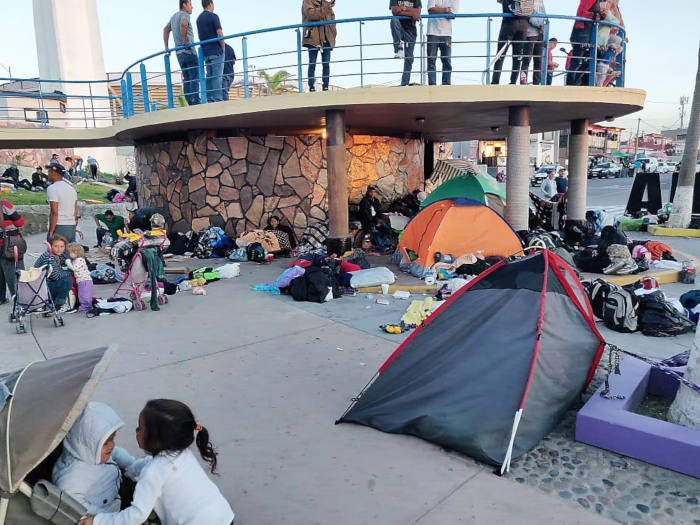-
06 August 2020
Category : Opinion
“The border is a point of transition, a temporary place that increases the vulnerability and difficulties facing migrants”
A EUROsociAL+ expert explains the vulnerability migrants face at borders

Bárbara Gómez, EUROsociAL+ project technician tells us about the dangers that migrants run at borders and how inequalities increase while they remain in this situation, particularly at the crossing between Mexico and the United States. She also speaks about how public policies are the key to guaranteeing a legal framework to protect the basic human rights of migrants.
Clearly, we have abandoned the usual idea of seeing a border as a mere line that can be easily erased, to look at it, like the philosopher Eugenio Trías, as an authentic territory in which not only conflicts or cultural clashes, but also multiple exchanges and trade-offs are evident. Above all, a different conception of the “experience of the limit”.
The flexibility of the mobility of people across these borders, added to the complexity of our current society, and the perennial problems of searching for opportunities due to poverty and social inequality in many countries, along with regional conflicts, has led to a migratory phenomenon that has itself increased to such an extent as to become a global situation. This reality has become more evident lately due to the latest events that occurred in the current context of the migration through Mexico where, in October 2018 a caravan began in which just over six thousand people came to Tijuana to seek asylum in the United States[1]. The focus on this event was sharpened by the continued strengthening of the south-west border of the United States, where the current president insists on building a border wall with Mexico, despite the Democrats’ opposition and refusal to approve expenditure for the wall.
Over the last 12 years, migration in Mexico has started to change profoundly in terms of numbers, patterns and impacts, in other words, a significant transformation in the migration dynamics in this region of the country has occurred. This new dynamic has brought consequences of a social, economic and cultural nature to the different border cities and to the region in general.
EUROsociAL+, the European Union programme run by FIIAPP, is watching the migratory phenomenon in the Latin American region, and particularly in the Central American region, and with a multidimensional approach, is also observing how migration is being managed in border areas, improving cross-border governance systems. Within this framework, it has overseen the preparation of a diagnostic study that focuses on all phases and stages of this phenomenon in a context of economic, social and political crisis.
To this end, there were several questions to answer: What will happen to undocumented migrants arriving at the south-western border of the United States? How likely is it that they will decide to reside in the border region of Mexico as they are unable to cross the border or request asylum? Is the Mexican government prepared for this possible contingency?
It was vitally important to analyse the initial situation in the border territories, which in most cases were not only forced to receive migrants from Central America unable to cross the border, but at the same time to receive all those who had been deported and were affected by the extremely strict migratory policies of the United States. The analysis started from this approach and how all this would affect a new organisation of the region, the public policies put in place for multilevel governance, regional cohesion and, therefore, for social cohesion as a response to the sense of belonging felt by such a heterogeneous group of citizens living on the border.
The study, therefore, aims to understand the journeys experienced by the migrants, as well as their experiences during their temporary or forced stay in the border cities of this region. The analysis included both Mexicans who have been deported or returned from the United States, as well as men and women from Central America and the Caribbean.
Mexico’s northern border includes the group of municipalities adjacent to the US border, on the assumption that this is where most of these events occur. Included in this area are 38 adjoining municipalities that belong to six states: Baja California, Sonora, Chihuahua, Coahuila, Nuevo León and Tamaulipas. It has now become a region with close ties to the United States; there are permanent exchanges of goods and services in both directions, as well as a huge flow of people who cross over in both directions every day. To mention just some interesting details. The Baja California border region has the highest number of immigrants (168,000); 38.4% of the population was born in a non-border region or outside Mexico. This percentage increases to over 50% in municipalities such as Tijuana and Tecate (Baja California). Baja California and Sonora have received most of the migrants deported from the USA. Jointly, 67% of the cases recorded took place in these two states. Men make up the vast majority of Mexicans repatriated from the United States, totalling 91% versus 9% women. However, the qualitative experience of this repatriation will not be the same for men and women, with the latter being the most vulnerable as, in most cases, they take their dependent children with them. But it is also notable that the vast majority of repatriation events involve young migrants; almost half are between 20 and 29 years old. Between January and October 2018, 9,348 minors (MENAS) were handed over to the Mexican authorities by their American peers, which represents 6% of the total.
The journeys taken by migrants
Also, it would not be entirely fair to present this work, which is sponsored by EUROsociAL+, only with statistical data. It is also only right to take into account the human dimension of all these experiences of “transition” that are exponentially increased by inequality.
Devoid of rights, and even devoid of the right to possess rights, undocumented migrants are nowadays the clearest expression of the conscious deprivation of basic human rights for a whole human group. By excluding them from legality, the State places undocumented migrants outside the limits of the law, at the same time that it applies laws that systematically exclude them. In other words, the vulnerability of this group is largely caused by the denial of their right of access to justice, and EUROsociAL+ is working to change this situation. Access to justice is a key right, which acts as a kind of gateway for access to basic services such as health, education, housing, employment, and so on. But it also entails the defence of aliens detained or deprived of liberty, care for victims of gender violence and legal assistance for unaccompanied minors.
Perhaps this ambiguous situation of being “outside the law” has led to certain situations of violence that migrants themselves suffer in their journey across borders. Without a legal framework that protects them, in no-man’s land, their lack of protection is greater and, therefore, their rights are weakened. One of the clearest examples of this form of violence is suffered by women. Women are in a very vulnerable situation when crossing borders. And EUROsociAL+ is addressing precisely the differentiated effects of corruption on women, pursuing two phenomena that do not always intersect: corruption and trafficking. Added to this equation is a more variable one, migration, since most women who are trafficked are also migrants.
At the border, migrants are at a crossroads between here and there, with their belongings in a backpack or in a plastic bag, and their dreams and hopes running high. In this border space, these people prefer information which is informal, which comes from family and friends, over any other source, to compensate for the extreme vulnerability of their border experience. Aware of this situation, EUROsociAL+ is also working so that this vulnerable group can fully exercise their right to access information; improving passive transparency with institutions that have the competence to manage this migratory phenomenon, but also a transparency that is active, promoting the exercise of these peoples’ rights to request basic information that can improve their lives in a country they do not know.
The border is a point of transition, of transience, a temporary place that increases their vulnerability, the difficulties they face. Sharing such vulnerability allows them to create deep ties during their short stay at the border, while deciding whether to move on or establish their new residence in the transit territories. Either decision will push them towards the most disadvantaged aspect of inequality. Governments must not forget about borders and must use all the instruments at their disposal so that the effects of their public policies also reach the inhospitable territories that are often forgotten.
Bárbara Gómez, Project Technician for the EUROsociAL+ Democratic Governance area at FIIAPP
[1] The Colegio de la Frontera, Northern Mexico (COLEF), 2018.
The views and opinions expressed in this blog are the sole responsibility of the person who write them.




